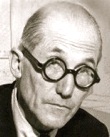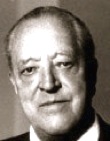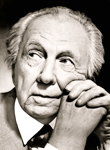EDUCATION AMONG THE MASTERS
EARLY EDUCATION
Johansen’s early education was at the progressive John Dewey School, where he was given the freedom to explore many different forms of artistic expression. At age 10 it was discovered that he could not read. After a change in schools and heart-wrenching struggles with reading (a lifelong challenge due to severe dyslexia, which was discovered later in life), he began to excel in his academics.
1922-26 Attended John Dewey School
1927-35 Attended Choate School
1936-39 Attended Harvard College
1939 Graduated from Harvard College, degree of B.S. Cum Laude
1939-42 Attended Harvard Graduate School of Design
When I graduated from Harvard, 1939, it was the only school in the United States that had undergone the modern evolution, as nurtured by the Bauhaus in Germany. We were keenly aware of Wright, who drew his spirit from Jeffersonian democracy and the philosophy of Whitman, Emerson and Thoreau, for their intense humanism, Yankee ingenuity, and simple moral values. - John M Johansen
HARVARD GRADUATE SCHOOL OF DESIGN
During the years 1939-42, Johansen attended the Harvard Graduate School of Design, studying with Marcel Breuer, Walter Gropius, Josef Albers.
I feel confident that most others with me at that time, Pei, Rudolph, Bruno Zevi, Barnes, and those later, Cobb and Franzen, and others, would agree with me that Harvard was an invaluable education in discipline and in the instilling of principles of the modern movement. Though we studied under the masters, we were not indoctrinated into a modern style, but given the guidelines to investigate an architecture for our time and circumstance. And we, the second generation of moderns, brought about and witnessed, in the 1950s and 1960s, what will well be recorded as the golden years of high modern. Most of the first generation modern architects, ‘the giants’ passed through our school. I am greatly proud to be of an age that I could, and did, talk numerous times with each of them. The modern movement was for us students at Harvard a fierce and joyous experience. - John M Johansen
MAJOR INFLUENCES
Major influences between the years 1943-45 were Frank Lloyd Wright, Le Corbusier, Eric Mendelsohn, Ludwig Mies van der Rohe, László Moholy-Nagy, Alvar Aalto and Buckminster Fuller.
Most of the first generation modern architects, ‘the giants’, passed through our school. I am greatly proud to be of an age that I could, and did, talk numerous times with each of them. The modern movement was for us students at Harvard a fierce and joyous experience....We were keenly aware of Wright, who drew his spirit from Jeffersonian democracy and the philosophy of Whitman, Emerson, and Thoreau, for their intense humanism, Yankee ingenuity, and simple moral values.
Certain personalities at Harvard were especially memorable: the austere Gropius, having held sway over the various arts at the Bauhaus, was for us the "Apollonian image." In the studios, while he smoked an occasional cigar, known as a "rum-soaked crook;' we would listen, transfixed, to his every word. At a picnic hosted by Gropius for his students, I, then twenty-two, met his daughter, Ati, who eventually became my wife.
The Gropius House in Lincoln was for me stunningly beautiful, resembling its master and creator in its haunting austerity. A curious incident occurred during its construction. Gropius asked the young Ati what material she would like on the floor of her room. She replied enthusiastically, "Sand!" But as her tender hopes were not granted by the master, it seemed there were limits, even to the freedoms offered by modern architecture. - John M Johansen































































Frank Lloyd Wright (1867 - 1959) forbade faculty to be present during his lectures at Harvard during the time Johansen was a student there, encouraging students to “leave Harvard immediately.” He said, "The architect must be a prophet… a prophet in the true sense of the term. If he can't see at least ten years ahead, don't call him an ‘architect.’“
Buckminster Fuller (1895 -1983) “A good friend of mine, one of the great geniuses of the United States (one of the few) ...stunning views on transdisciplinarity. When he asked an architect 'how much does your building weigh?' it was a shocking thing... That then paved the way for the whole movement of lighter, quicker, less expensive, more serviceable buildings. And of course, these are the pressures that dominate today due to costs. So he has been a very real influence on me.”
- John M Johansen
Mies van der Rohe (1886 - 1969) Greatly admired by Johansen, Meis was a major force in Johansen’s formative years of architecture. Widely acknowledged as one of the pioneers of Modern Architecture, he studied philosophy and incorporated a high level of abstraction in his architecture. As Nazi pressures escalated in Germany, Mies - who briefly served as the last Bauhaus Director in 1933 - was forced to close the school; he emigrated to the US in 1937.
Walter Gropius (1883 - 1969) was a German architect and founder of the Bauhaus School. Along with Ludwig Mies van der Rohe and Le Corbusier, Gropius is widely regarded as one of the pioneering masters of modern architecture. As a student in Gropius’ first class at Harvard, Johansen fondly remembers attending a picnic where he met Gropius’ beautiful young daughter, Ati, who was there with her father. Many years later he married her.
Charles-Édouard Jeanneret-Gris (1887 - 1965), popularly known as Le Corbusier, was a Swiss architect, designer, urbanist, painter, and writer. Famous for being one of the pioneers of Modern Architecture, he was a close friend of John Johansen’s.
Josef Albers (1888 - 1976) A German-born American artist and educator, Albers’ use of patterns and intense colors heavily influenced American artists, including John Johansen, and formed the basis of some of the most far-reaching art education programs of the 20th century. John Johansen’s wife, Ati Gropius, is a former graduate student of Albers who has been teaching his approach to color for many years.
Marcel Breuer (1902 - 1981) was an architect and furniture designer who studied at the Bauhaus and later taught at Harvard’s Architecture school. Born in Hungary, Breuer immigrated to London then the US, during Nazi rise to power. Considered to be one of the masters of Modern Architecture, he is best known for his architecture of the Whitney Museum of Modern Art. A colleague and friend of Walter Gropius, he was one of the famed “Harvard Five” and good friends with John Johansen.

Website Copyright © 2011 John M Johansen All Rights Reserved
No information, photos, videos or audio on this website may be distributed, copied
or otherwise used without the written permission of John M Johansen or his representative
Website created by John Veltri and Marguerite Lorimer EarthAlive Communications www.earthalive.com
Please direct inquires to info@earthalive.com


Bauhaus was very strong in its emphasis on building technologies. 'Minimal effort to produce a maximum result' - this principle really caught me. I believe that the ultimate expression that we are presented with in the finished work of architecture has to be a stunning result, but it has to be derived only through a very serious investigation of the needs and purpose of the building and the structure of the building. To say that in another way, architecture is a service art. If it doesn't serve then it's not architecture. Ipso facto, it is structure. It has to be so, and my position is based on that. I believe in design from the bottom up. I believe in taking seriously the program, the requirements, the budget and the site conditions, and out of that I have the confidence that I can bring out something beautiful. This is opposed to architects - and I won't mention names to you, but they'll be obvious - who design from the top down. They start with a precious image and from there they somehow expect it to be built. This is shocking to me.
- John M Johansen in an interview with Hans Ulrich Obrist
DESIGN FROM THE BOTTOM UP